Want to improve your health? Start eating the rainbow!
- Replies 5
We're always told to 'eat the rainbow' – that is, to include foods of every colour in our diets. (And no, we don't mean Skittles!)
But have you ever wondered why? As it turns out, there's actually a very good reason for this advice!
A diet rich in colourful fruits and vegetables could have significant health benefits – from assisting with weight loss and improving brain function to boosting immunity and even lowering the risk of diseases.
So, what should you be eating, and how can it help?
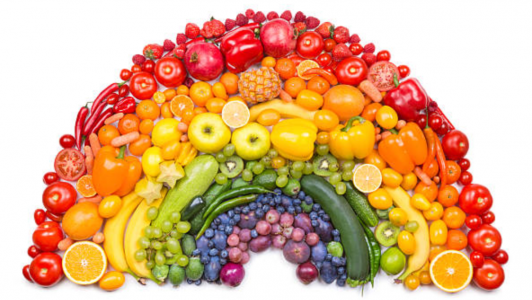
Red foods like apples, red cabbage, red onion, red peppers, strawberries, tomatoes, cherries, watermelon, and red capsicums are loaded with antioxidants like lycopene that could help lower the risk of heart disease by reducing inflammation.
They also contain compounds that may help keep our blood pressure down and improve cholesterol levels by removing plaque from artery walls.
Meanwhile, orange and yellow foods such as rockmelon, carrots, butternut squash, lemons, mango, oranges, papaya, peaches, pineapples, pumpkin, sweet potatoes, yellow capsicums, and corn are great for eye health thanks to their high levels of beta-carotene (which our bodies convert into Vitamin A).
They also contain Vitamin C, which can help boost immunity by protecting cells against damage. These tasty fruits & veggies are also anti-inflammatory and protect us against conditions like arthritis later in life.
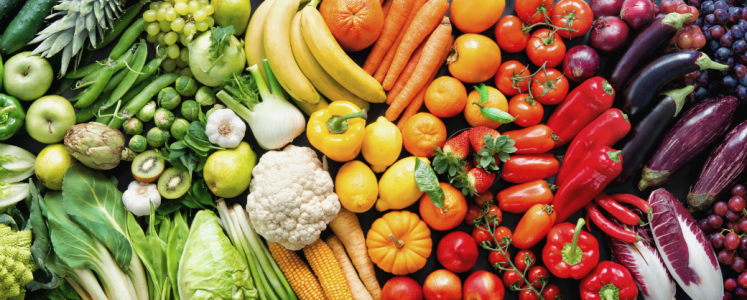
Green leafy vegetables should definitely be a staple in any healthy diet! Asparagus, bok choy, broccoli, cabbage, cucumbers, grapes, green beans, green capsicums, honeydew, kale, peas, spinach – these super greens are packed with nutrients like chlorophyll, carotenoids, isothiocyanates, omega-3 fatty acids.
Eating them regularly has been linked with a lower risk of developing various chronic diseases like type II diabetes & cancer. The high quantities of vitamin K (which aids in calcium binding to bones) in these foods make them wonderful for bone health, and their low calorie and high fibre content (which keeps us feeling fuller for longer) also makes them useful for weight loss.
Blue and purple foods get their vibrant colours from anthocyanins, a type of flavonoid that acts as an antioxidant in the body. These health-boosting properties make dark beans, eggplant, beets, blueberries, blackberries, and figs great for brain function as they could help protect cells in the brain from damage caused by free radicals.
They may also help keep our minds sharp as we age and have even been linked to a reduced risk of Alzheimer's disease.
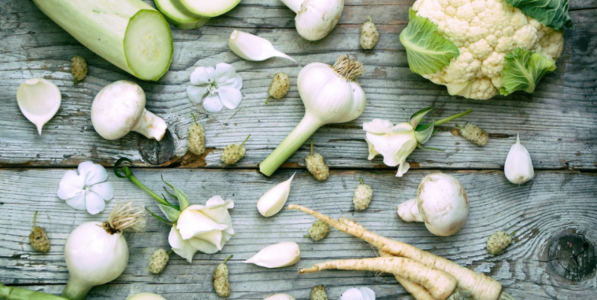
Finally, white foods like ginger, onions, mushrooms, and cauliflower might not be the most exciting to look at, but they're definitely worth including in your diet!
Many essential nutrients can be found in white foods, including anthoxanthins, which have been shown to reduce cholesterol and blood pressure, and sulphur, which aids in liver detoxification and contributes to the formation of proteins and skin health.

So there you have it – a few good reasons to start 'eating the rainbow'! The next time you do your grocery shopping, make sure to pick up a variety of colourful fruits and vegetables so you can boost your health in a tasty way!
If you want to expand the spectrum of colours in your diet, here are some recipes from Sarah Di Lorenzo, a clinical nutritionist, you might want to try:
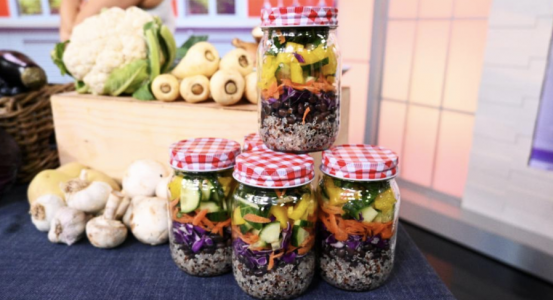
Rainbow salad jars
Ingredients
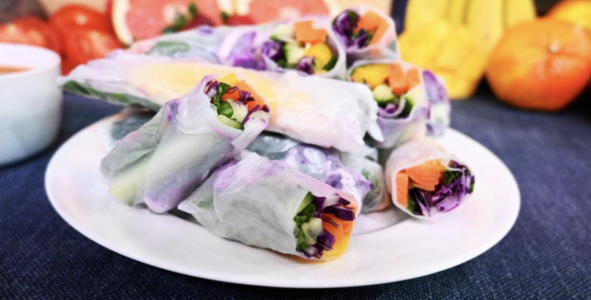
Rainbow rice paper rolls
Ingredients
But have you ever wondered why? As it turns out, there's actually a very good reason for this advice!
A diet rich in colourful fruits and vegetables could have significant health benefits – from assisting with weight loss and improving brain function to boosting immunity and even lowering the risk of diseases.
So, what should you be eating, and how can it help?

Eating a rainbow of coloured fruits and vegetables can ensure you receive a variety of nutrients. Credit: iStock.
Red foods like apples, red cabbage, red onion, red peppers, strawberries, tomatoes, cherries, watermelon, and red capsicums are loaded with antioxidants like lycopene that could help lower the risk of heart disease by reducing inflammation.
They also contain compounds that may help keep our blood pressure down and improve cholesterol levels by removing plaque from artery walls.
Meanwhile, orange and yellow foods such as rockmelon, carrots, butternut squash, lemons, mango, oranges, papaya, peaches, pineapples, pumpkin, sweet potatoes, yellow capsicums, and corn are great for eye health thanks to their high levels of beta-carotene (which our bodies convert into Vitamin A).
They also contain Vitamin C, which can help boost immunity by protecting cells against damage. These tasty fruits & veggies are also anti-inflammatory and protect us against conditions like arthritis later in life.

The bright colours in fruits and vegetables are actually due to the phytonutrients they contain. Credit: iStock.
Green leafy vegetables should definitely be a staple in any healthy diet! Asparagus, bok choy, broccoli, cabbage, cucumbers, grapes, green beans, green capsicums, honeydew, kale, peas, spinach – these super greens are packed with nutrients like chlorophyll, carotenoids, isothiocyanates, omega-3 fatty acids.
Eating them regularly has been linked with a lower risk of developing various chronic diseases like type II diabetes & cancer. The high quantities of vitamin K (which aids in calcium binding to bones) in these foods make them wonderful for bone health, and their low calorie and high fibre content (which keeps us feeling fuller for longer) also makes them useful for weight loss.
Blue and purple foods get their vibrant colours from anthocyanins, a type of flavonoid that acts as an antioxidant in the body. These health-boosting properties make dark beans, eggplant, beets, blueberries, blackberries, and figs great for brain function as they could help protect cells in the brain from damage caused by free radicals.
They may also help keep our minds sharp as we age and have even been linked to a reduced risk of Alzheimer's disease.

White veggies and foods can be equally as nutritious as their coloured counterparts. Credit: Joy Bauer.
Finally, white foods like ginger, onions, mushrooms, and cauliflower might not be the most exciting to look at, but they're definitely worth including in your diet!
Many essential nutrients can be found in white foods, including anthoxanthins, which have been shown to reduce cholesterol and blood pressure, and sulphur, which aids in liver detoxification and contributes to the formation of proteins and skin health.
Tip
- Choose a variety of different-coloured whole foods throughout the week.
- The more naturally occurring colours on your plate at each meal or snack, the better.
- It does NOT mean making a rainbow with artificially coloured foods (lollies, soft drinks, fast food, etc.).
If you want to expand the spectrum of colours in your diet, here are some recipes from Sarah Di Lorenzo, a clinical nutritionist, you might want to try:

When you don't feel like preparing a full meal for yourself, these jars of rainbow vegetables are a great option to have on hand. Credit: 7News.
Rainbow salad jars
Ingredients
- 1/2 cup of cooked quinoa
- 1/2 cup of black olives
- 1/2 cup of chopped capsicum
- 1/2 cup of chopped purple cabbage
- 1/2 cup of shredded carrots
- 10 spinach leaves
- 1/2 cup of corn
- 1 tablespoon of lemon juice
- 1 tablespoon of extra virgin olive oil
- 1/2 teaspoon of garlic powder
- Salt and pepper
- Cook the quinoa in salted boiling water, just like rice. Once the quinoa has cooled, you may layer it at the bottom of a jar.
- Fill the jar with layers of vegetables. The order is important, so put the wetter and heavier ingredients on the bottom and the spinach or cabbage on top.

These rainbow rice paper rolls are the perfect solution for a quick, simple, and wholesome dinner option. Credit: 7News.
Rainbow rice paper rolls
Ingredients
- 8 rice paper roll sheets
- 1 carrot peeled and cut into small strips
- 1 cucumber cut into strips
- 1/2 capsicum cut into strips
- 1/2 of purple cabbage thinly sliced
- 1 handful of fresh basil
- 1 handful of fresh mint
- 1/2 mango
- 3 tablespoons of peanut butter
- 1 tablespoon of sesame oil
- 2 tablespoons of tamari
- 1 tablespoon of sriracha
- 1 teaspoon of chopped fresh ginger
- 1 clove of garlic, minced
- Pinch of chilli flakes
- 2 tablespoons of warm water
- Sesame seeds
- Peanuts
- To prevent the rolls from drying out, dampen two tea towels. These will be used to hold the finished rolls.
- Put water in a large bowl, put a sheet of rice paper in the water, and let it soak for 30 seconds. After that, put the rice paper on a cutting board and fill the centre with the ingredients.
- Roll it up, close the ends by folding them in, and set it on the damp tea towel. Keep going until all of the ingredients are used.
- In a bowl, combine and thoroughly mix all the dipping ingredients.
- Sprinkle some toasted sesame seeds and chopped peanuts on top before serving.







